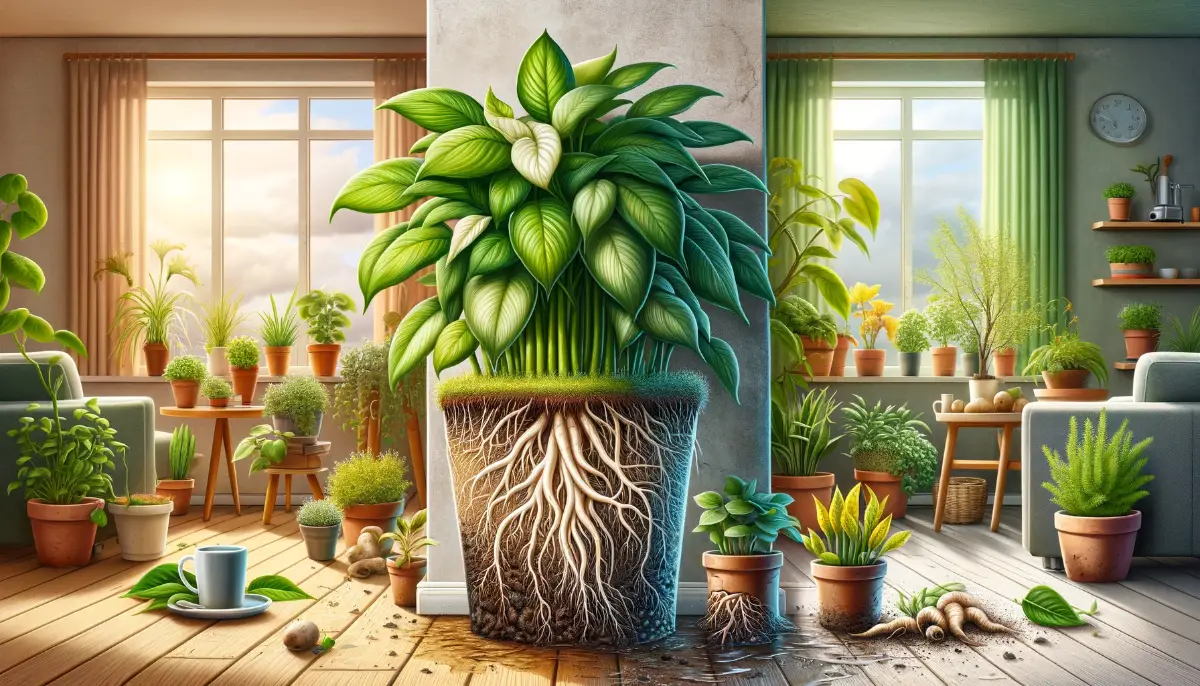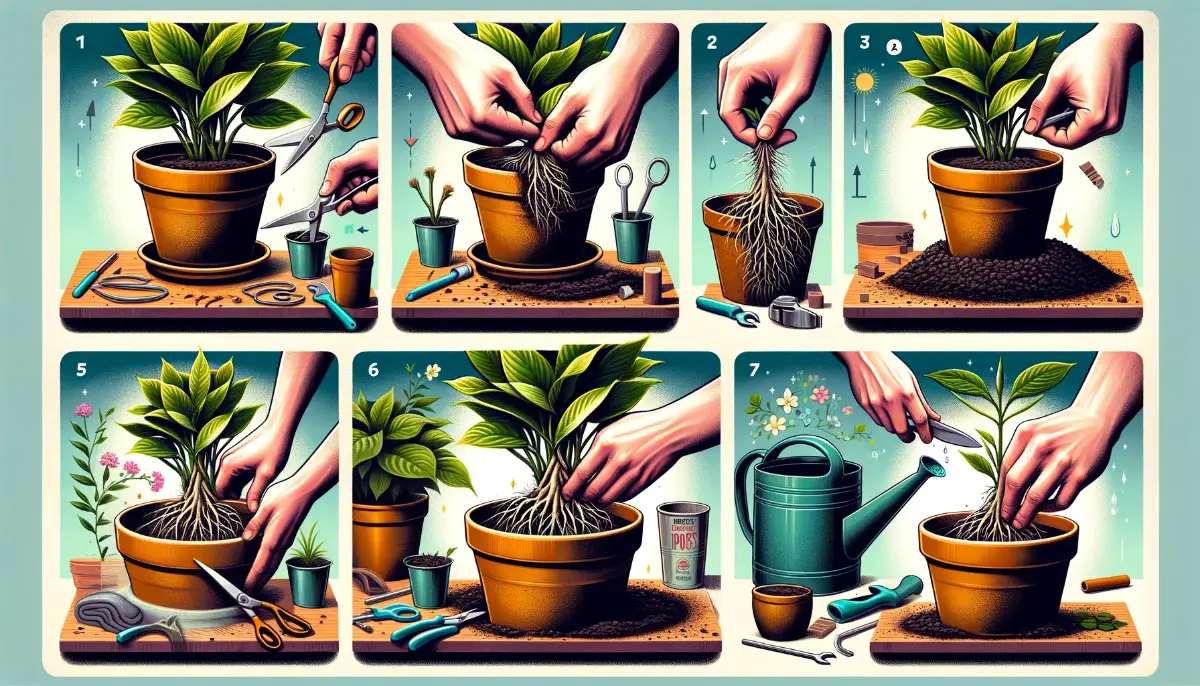Root rot is an insidious enemy of indoor plants, striking silently and often unnoticed until it’s too late. This condition, primarily caused by overwatering and poor drainage, can devastate indoor gardens, leading to the demise of beloved plants. Understanding root rot – its causes, signs, and solutions – is essential for every indoor gardener who seeks to maintain a healthy, vibrant garden.
What is Root Rot
Root rot is primarily caused by overwatering, leading to an anaerobic (oxygen-starved) environment around the roots that fosters the growth of fungi and other pathogens. These conditions are detrimental to plants, as roots are essentially suffocated, unable to absorb water and nutrients effectively.
This is exacerbated by poor soil drainage, compacted soil, and the presence of pathogenic fungi such as Phytophthora, Fusarium, and Pythium. Symptoms often include yellowing leaves, wilting, and stunted growth, with roots turning brown or black and becoming mushy to the touch.
Identifying root rot in an indoor garden is crucial for the health and longevity of your plants. Root rot is a condition that can severely affect the root system of plants, leading to stunted growth, yellowing leaves, and ultimately, the demise of the plant if not addressed promptly. Here’s how you can identify root rot in your indoor garden:
Early Warning Signs
Stunted Growth: If your plant is not growing as expected or its growth has suddenly halted, it might be experiencing root rot.
Yellowing Leaves: One of the first noticeable symptoms of root rot is the yellowing of leaves. While yellow leaves can indicate various issues, coupled with other signs, they can point to root rot.
Wilting: A plant with root rot may appear wilted or droopy, even with adequate watering.
Inspecting the Roots
The most definitive way to diagnose root rot is by inspecting the roots directly:
Soft, Brown Roots: Healthy roots should be firm and white. If the roots are soft, brown or black, and easily break apart, it is a sign of root rot.
Musty Smell: A foul or musty odor coming from the potting soil is another indication of root rot, caused by the decay of the roots.
Reduced Root Mass: If the root system seems diminished or has dead sections, it could be due to root rot.
Environmental Conditions
Root rot often results from environmental conditions that favor its development:
Overwatering: The most common cause of root rot is overwatering, leading to waterlogged soil conditions that lack sufficient oxygen for healthy root growth.
Poor Drainage: Containers without adequate drainage or soil that retains too much water can create an environment conducive to root rot.
Lack of Air Circulation: Stagnant air around the plant and soil surface can further exacerbate the conditions for root rot.
Treating Root Rot
Upon discovering root rot, immediate action is necessary. The first step involves removing the plant from its pot and gently cleaning the roots under running water. Infected roots must be pruned away, leaving only healthy tissue.
This step requires sterilized tools to prevent further spread of disease. Following this, repotting the plant in fresh, well-draining soil and a clean or new pot is crucial. For severe cases, a fungicide may be necessary, but the focus should shift to prevention to avoid future outbreaks..
Organic Remedies for Root Rot
Cinnamon Powder Solution
Cinnamon, known for its natural antifungal properties, can be a gardener’s ally against root rot. To create a cinnamon powder solution, simply mix ground cinnamon with water to form a paste. This paste can be applied directly to the affected roots after they’ve been cleaned and trimmed of any rot. Additionally, sprinkle a bit of dry cinnamon powder onto the soil’s surface to act as a preventive measure against surface-level fungal growth.
Chamomile Tea Spray
Chamomile tea is celebrated not only for its soothing effects on humans but also for its mild fungicidal properties that can benefit plants. Brew a strong chamomile tea, let it cool, and then use it to water your plants or as a spray on the foliage and soil. This gentle treatment can help prevent fungal growth without introducing harsh chemicals into your indoor garden ecosystem.
Hydrogen Peroxide Mixture
Hydrogen peroxide (3% solution) is a powerful oxidizer that kills bacteria and fungi on contact, while also adding oxygen to the soil, which can help revitalize suffocating roots. Mix one part hydrogen peroxide with two parts water. Use this solution to water the affected plants, ensuring that the soil is thoroughly drenched. This method is particularly effective for plants already suffering from the early stages of root rot, as it can help stop the progression of the disease
Preventing Root Rot
Prevention is the cornerstone of managing root rot. Key strategies include:
- Proper Watering: Overwatering is the root cause of root rot. Plants should only be watered when the top inch of soil is dry to the touch, and the pot should allow excess water to drain freely.
- Good Drainage: Ensuring pots have adequate drainage holes and using a well-draining soil mix can significantly reduce the risk of root rot. Adding perlite or sand can improve soil aeration and drainage.
- Monitoring Plant Health: Regularly inspect plants for signs of distress. Early detection of root rot or other diseases can save a plant and prevent the spread to others.
- Tool Hygiene: Sterilizing pruning tools before use can prevent the transfer of fungi and other pathogens between plants.
- Environmental Control: Providing sufficient light, air circulation, and humidity levels can promote healthy plant growth, making plants less susceptible to diseases like root rot.
FAQs for Root rot in indoor garden
What causes root rot in indoor plants?
Root rot in indoor plants is primarily caused by overwatering, leading to anaerobic conditions around the roots that favor the growth of harmful fungi and bacteria. Poor drainage and compacted soil can also contribute to the problem by retaining excess moisture.
How can I tell if my indoor plant has root rot?
Signs of root rot include yellowing leaves, wilting, and stunted growth despite adequate watering. The most definitive sign is inspecting the roots themselves; they will be brown or black, mushy, and might have a foul smell.
Can a plant recover from root rot?
Yes, a plant can recover from root rot if the condition is identified early and treated promptly. This involves removing the affected parts of the root, treating the remaining healthy roots, and repotting in fresh, sterile soil.
Are certain plants more susceptible to root rot?
While any plant can suffer from root rot under the right conditions, those that require well-drained soil or have specific water needs are more susceptible, especially if their care requirements are not met.
How do I treat root rot organically in my indoor garden?
After removing the affected roots, treat the remaining roots with a hydrogen peroxide solution or natural fungicides like cinnamon powder. Repot the plant in a fresh, sterile potting mix and adjust your watering habits.
How often should I water my indoor plants to prevent root rot?
Watering frequency depends on the plant species, but a good rule of thumb is to let the top inch or two of soil dry out before watering again. Always check the soil moisture level before watering.
Can root rot spread from one plant to another?
Yes, root rot can spread from one plant to another if they share the same water or if tools used on an infected plant are not sterilized before being used on healthy plants.
What type of potting mix should I use to prevent root rot?
Use a well-draining potting mix that allows for proper air circulation around the roots. Mixes containing perlite, vermiculite, or sand can help improve drainage and prevent waterlogging.
Is it possible to reuse a pot that had a plant with root rot?
Yes, but you should thoroughly clean and disinfect the pot with a solution of 1 part bleach to 9 parts water to kill any remaining pathogens before using it again.
How can I improve drainage in my indoor plant pots to prevent root rot?
Ensure your pots have drainage holes at the bottom. You can also add a layer of gravel or broken pieces of terracotta pots at the bottom of the pot before adding soil, which can help prevent the soil from blocking the drainage holes and allow excess water to escape more easily










